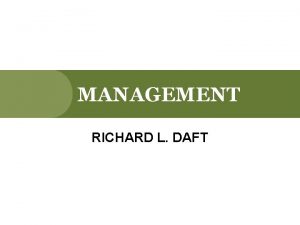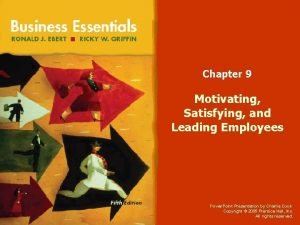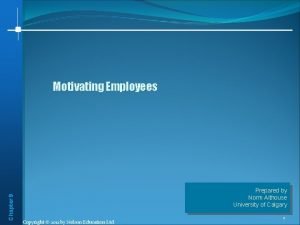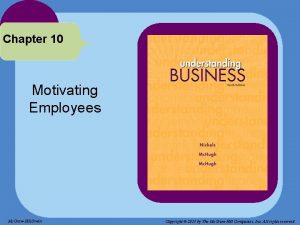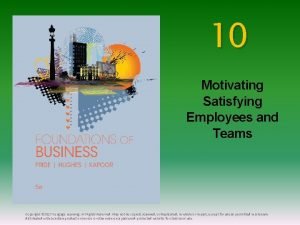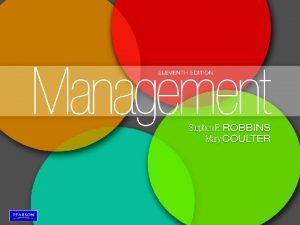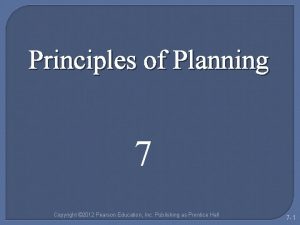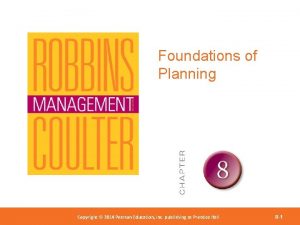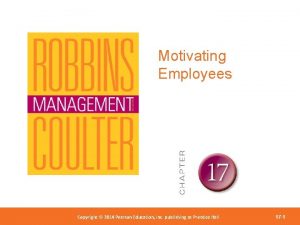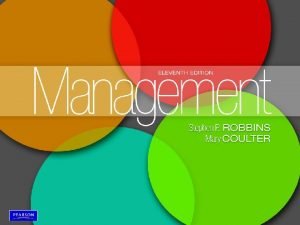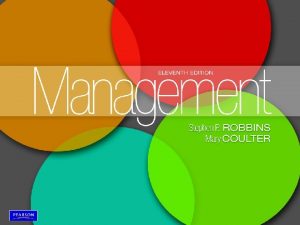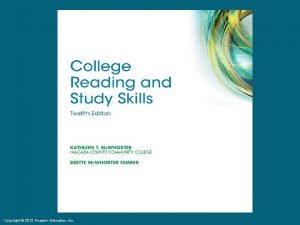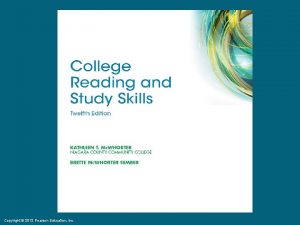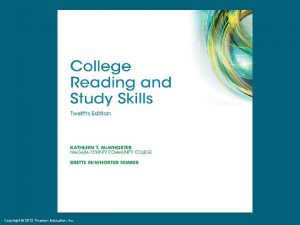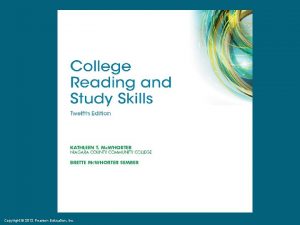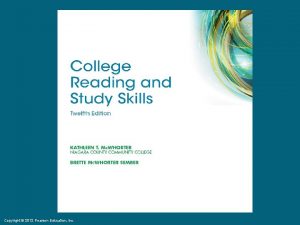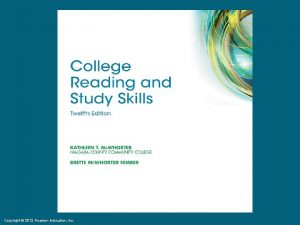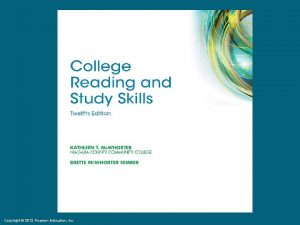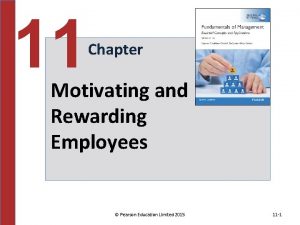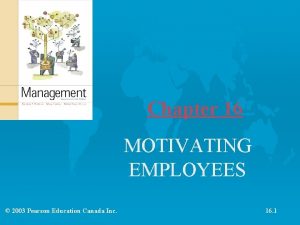Motivating Employees Copyright 2012 Pearson Education Copyright 2014



















- Slides: 19

Motivating Employees Copyright 2012 Pearson Education, Copyright © 2014 Pearson©Education, Inc. publishing as Prentice Hall Inc. Publishing as Prentice Hall 17 -1

What Is Motivation? • Motivation - the process by which a person’s efforts are energized, directed, and sustained toward attaining a goal. – energy is a measure of intensity, drive, and vigor – effort is channeled in a direction that benefits the organization – We want employees to persist in putting forth effort Copyright 2012 Pearson Education, Copyright © 2014 Pearson©Education, Inc. publishing as Prentice Hall Inc. Publishing as Prentice Hall 17 -2

Early Theories of Motivation • Maslow’s Hierarchy of Needs • Mc. Gregor’s Theories X and Y Copyright 2012 Pearson Education, Copyright © 2014 Pearson©Education, Inc. publishing as Prentice Hall Inc. Publishing as Prentice Hall 17 -3

Maslow’s Hierarchy of Needs Theory • Hierarchy of needs theory - Maslow’s theory that human needs — physiological, safety, social, esteem, and selfactualization — form a sort of hierarchy. • Physiological needs - a person’s needs for food, drink, shelter, sexual satisfaction, and other physical needs. Copyright 2012 Pearson Education, Copyright © 2014 Pearson©Education, Inc. publishing as Prentice Hall Inc. Publishing as Prentice Hall 17 -4

Maslow’s Hierarchy of Needs Theory (cont. ) • Safety needs - a person’s needs for security and protection from physical and emotional harm. • Social needs - a person’s needs for affection, belongingness, acceptance, and friendship. Copyright 2012 Pearson Education, Copyright © 2014 Pearson©Education, Inc. publishing as Prentice Hall Inc. Publishing as Prentice Hall 17 -5

Maslow’s Hierarchy of Needs Theory (cont. ) • Esteem needs - a person’s needs for internal factors (e. g. , self-respect, autonomy, and achievement) and external factors (such as status, recognition, and attention). • Self-actualization needs - a person’s need to become what he or she is capable of becoming. Copyright 2012 Pearson Education, Copyright © 2014 Pearson©Education, Inc. publishing as Prentice Hall Inc. Publishing as Prentice Hall 17 -6

Maslow’s Hierarchy of Needs Copyright 2012 Pearson Education, Copyright © 2014 Pearson©Education, Inc. publishing as Prentice Hall Inc. Publishing as Prentice Hall 17 -7

Trapped in a cave Wild Lion outside Copyright 2012 Pearson Education, Copyright © 2014 Pearson©Education, Inc. publishing as Prentice Hall Inc. Publishing as Prentice Hall 17 -8

Mc. Gregor’s Theory X and Theory Y • Theory X - the assumption that employees dislike work, are lazy, avoid responsibility, and must be coerced to perform. • Theory Y - the assumption that employees are creative, enjoy work, seek responsibility, and can exercise selfdirection. Copyright 2012 Pearson Education, Copyright © 2014 Pearson©Education, Inc. publishing as Prentice Hall Inc. Publishing as Prentice Hall 17 -9

Who is Theory X? Who is Theory Y? Your professors? Copyright 2012 Pearson Education, Copyright © 2014 Pearson©Education, Inc. publishing as Prentice Hall Inc. Publishing as Prentice Hall 17 -10

Designing Motivating Jobs • Job design - the way tasks are combined to form complete jobs. • Job scope - the number of different tasks required in a job and the frequency with which those tasks are repeated. • Job enlargement - the horizontal expansion of a job that occurs as a result of increasing job scope. Copyright 2012 Pearson Education, Copyright © 2014 Pearson©Education, Inc. publishing as Prentice Hall Inc. Publishing as Prentice Hall 17 -11

Designing Motivating Jobs (cont. ) • Job enrichment - the vertical expansion of a job that occurs as a result of additional planning and evaluation of responsibilities. • Job depth - the degree of control employees have over their work. • Job characteristics model (JCM) - a framework for analyzing and designing jobs that identifies five primary core job dimensions, their interrelationships, and their impact on outcomes. Copyright 2012 Pearson Education, Copyright © 2014 Pearson©Education, Inc. publishing as Prentice Hall Inc. Publishing as Prentice Hall 17 -12

Equity Theory • Equity theory - theory that an employee compares his or her job’s input-outcome ratio with that of relevant others and then corrects any inequity. • Referents - the persons, systems, or selves against which individuals compare themselves to assess equity. • Distributive justice - perceived fairness of the amount and allocation of rewards among individuals. Copyright 2012 Pearson Education, Copyright © 2014 Pearson©Education, Inc. publishing as Prentice Hall Inc. Publishing as Prentice Hall 17 -13

Equity Theory (Course Example? ) Copyright 2012 Pearson Education, Copyright © 2014 Pearson©Education, Inc. publishing as Prentice Hall Inc. Publishing as Prentice Hall 17 -14

Current Issues in Motivation • Motivating in Tough Economic Circumstances – The economic recession of the last few years was difficult for many organizations – Layoffs, tight budgets, minimal or no pay raises, benefit cuts, no bonuses, long hours doing the work of those who had been laid off — was the reality that many employees faced. Copyright 2012 Pearson Education, Copyright © 2014 Pearson©Education, Inc. publishing as Prentice Hall Inc. Publishing as Prentice Hall 17 -15

Current Issues in Motivation (cont. ) • Managing Cross-Cultural Motivational Challenges – Most current motivation theories were developed in the United States by Americans and about Americans – Managers can’t automatically assume motivational programs that work in one geographic location are going to work in others Copyright 2012 Pearson Education, Copyright © 2014 Pearson©Education, Inc. publishing as Prentice Hall Inc. Publishing as Prentice Hall 17 -16

Current Issues in Motivation (cont. ) • Motivating Professionals – Characteristics of professionals • Strong and long-term commitment to their field of expertise • Loyalty is to their profession, not to the employer • Have the need to regularly update their knowledge • Don’t define their workweek as 8: 00 am to 5: 00 pm. Copyright 2012 Pearson Education, Copyright © 2014 Pearson©Education, Inc. publishing as Prentice Hall Inc. Publishing as Prentice Hall 17 -17

Current Issues in Motivation (cont. ) • Motivating Contingent Workers – Opportunity to become a permanent employee – Opportunity for training – Equity in compensation and benefits • Motivating Low-Skilled, Minimum-Wage Employees – Employee recognition programs – Provision of sincere praise Copyright 2012 Pearson Education, Copyright © 2014 Pearson©Education, Inc. publishing as Prentice Hall Inc. Publishing as Prentice Hall 17 -18

Designing Appropriate Rewards Programs • Open-book management - a motivational approach in which an organization’s financial statements (the “books”) are shared with all employees. • Employee recognition programs - programs based on personal attention and expression of interest, approval, and appreciation for a job well done. • Pay-for-performance programs - variable compensation plans that pay employees on the basis of some performance measure. Copyright 2012 Pearson Education, Copyright © 2014 Pearson©Education, Inc. publishing as Prentice Hall Inc. Publishing as Prentice Hall 17 -19
 2014 pearson education inc
2014 pearson education inc Herzberg’s two-factor theory
Herzberg’s two-factor theory Reinforcement theory of motivation
Reinforcement theory of motivation Motivating employees without money
Motivating employees without money Motivating and satisfying employees and teams
Motivating and satisfying employees and teams Chapter 10 motivating and satisfying employees and teams
Chapter 10 motivating and satisfying employees and teams Motivating and satisfying employees and teams
Motivating and satisfying employees and teams Chapter 10 motivating employees
Chapter 10 motivating employees Chapter 10 motivating employees
Chapter 10 motivating employees Chapter 10 motivating employees
Chapter 10 motivating employees Copyright
Copyright Pearson education inc. 2012
Pearson education inc. 2012 2012 pearson education inc
2012 pearson education inc 2012 pearson education inc
2012 pearson education inc 2012 pearson education inc
2012 pearson education inc Cranial cephalic
Cranial cephalic Pearson education inc. 2012
Pearson education inc. 2012 Pearson education inc. 2012
Pearson education inc. 2012 2012 pearson education inc anatomy and physiology
2012 pearson education inc anatomy and physiology Pearson mbo
Pearson mbo




